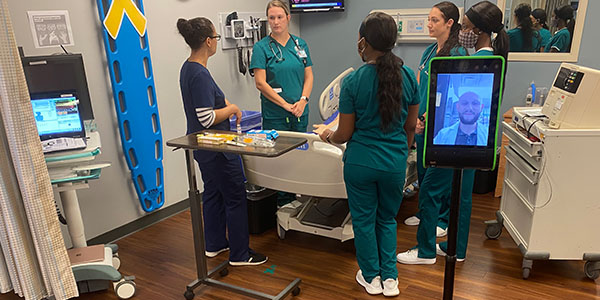There are now sleek, high-tech teaching tools rolling around the Simulation Training and Applied Research (STAR) Center at Jacksonville University’s Keigwin School of Nursing.
This summer, with the help of EPIC funding, nursing faculty introduced two telepresence robots into the curriculum as part of a strategic effort to expose upper-level nursing students to telehealth technology, which continues to exponentially grow in the post-COVID era.
“The overall goal of these robots is to familiarize our students with technology they will likely interact with at some point in their career,” says Clinical Assistant Professor of Nursing Amber Santos, who also serves as Director of Innovation and Quality at the Keigwin School of Nursing.

The Centers for Disease Control and Prevention defines telehealth as the use of two-way telecommunications technologies to provide clinical healthcare through a variety of remote methods. In February 2020, as the COVID-19 pandemic was beginning to grow in the United States, the CDC advised healthcare providers to offer clinical services through virtual means such as telehealth. According to the CDC, during the first quarter of 2020, the number of telehealth visits increased by 50 percent, compared with the same period in 2019, with a 154 percent increase in week 13 of 2020, compared with the same period in 2019.
While the COVID-19 pandemic has accelerated the use of telehealth technology across the healthcare industry, Santos says nurses and other healthcare professionals do not always feel adequately trained to use it.
“Part of our job as nurse educators is to prepare our students for the future of healthcare; it’s important that we cultivate curious minds and help them see past the present to what will be,” says Santos. “My goal is to introduce technology consistently and strategically into our curriculum. I strongly believe that immersive learning — whether it’s virtual reality, augmented reality, artificial intelligence, etc. — is the best way to enhance our students’ education and get them excited to learn. A nurse who is a life-long learner is also an intelligent, safe nurse, and that is exactly what our community needs.”
The two telepresence robots introduced at KSON this summer are made by Double Robotics, and nursing faculty appropriately named them after the beloved JU mascots, Nellie and Dunk’N. The remotely-controlled robots stand about 4 feet tall, weigh 16 pounds, and have two wheels at the bottom, allowing for 360-degree maneuverability much like a Segway. They feature a tablet-sized screen at the top with a camera and microphone that allows students to hear and speak to a “physician.”
“We selected this model because, among other things, it was the only robot to offer a self-driving mode, which allows you to maneuver around any space with a single click,” says JU Simulation Operations Specialist Bobby Davidson, who played the role of the physician during initial testing in the STAR Center this summer. “The robot was built with a robust array of cameras and sensors working together with object detection AI, allowing it to map out safe driving surfaces as well as people, furniture, and other physical objects which it will avoid.”
Armed with a faculty-provided script and a laptop, Davidson uses an internet browser to view a live, high-definition video feed of the space in front of the robot and communicate with students in the STAR Center. “This means the robot is device agnostic and can be operated by almost any computer, tablet, or smartphone,” says Davidson. “The experience is not unlike a Zoom call, the only difference is you can drive the camera like a car.”
Spinning the camera in the chosen direction, Davidson can maneuver the robot to the bedside of the patient — in this case, a high-fidelity medical manekin — where nursing students report on the status of their “patient” and seek guidance from the physician. The simulation is part of a Rapid Response Team scenario.
“Students will have to effectively communicate with the physician — an actor, who is ‘present’ via the robot — as the patient’s condition deteriorates,” says Santos. “The telepresence robots will introduce our students to various scenarios in the hospital setting, such as patients in quarantine, telehealth, consults from physicians and specialists from all over the world, interdisciplinary rounding, central supply delivery capabilities, and much more.”
The robot also has a feature that allows nurses at the patient’s bedside to wirelessly connect their mobile device and activate the camera on that device. “This could be useful in situations where a doctor needs to see a close up of a wound, as an example. The nurse can use their mobile device to assist the doctor in seeing the wound more clearly,” says Davidson.
After testing the technology this summer, nursing faculty and STAR Center staff will take over the robot operation and physician role in these telehealth simulations. And Santos isn’t limiting this technology to patient care scenarios in the center.
“We are also using the robots for mock job interviews with our senior nursing students,” said Santos. “We invited our industry partners at Baptist Health and some of our other faculty members to log on remotely from their offices and interview a panel of nursing students via the telepresence robots. It’s a wonderful way to help our students prepare for real job interviews and strengthen their soft skills.”

Santos is also deploying the use of Virtual Reality headsets into the nursing curriculum to expose students to even more real-world clinical experiences and accelerate their preparation to enter the nursing field.
By Laura Phelps
 Wave Magazine Online Jacksonville University News Hub
Wave Magazine Online Jacksonville University News Hub


